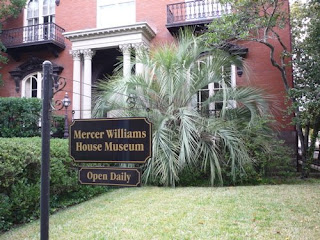Escape from Savannah, 1928: Young John Mercer Moves to New York
 During my stroll last week through the historic sections of Savannah, Georgia, a visit that included Flannery O'Connor's childhood home and many moss-covered trees, I meandered over to the Mercer-Williams House. Most know this landmark from The Midnight in the Garden of Good and Evil as the house built by General Hugh W. Mercer, the great grandfather of songwriter Johnny Mercer. Neither the General nor Johnny Mercer ever lived there. Jim Williams bought the place in 1969 with the intent to restore it to its former glory, and the house is where the murder depicted in Berendt's book took place. The architect of the original house, a New York native named John S. Norris, was proficient in the styles of the era and designed some of the most important buildings in pre-Civil War Savannah, including this house, the Andrew Low House, and the Unitarian Church. The construction began in 1860 and was completed after the war. Norris returned to NYC at the outbreak of the war.
During my stroll last week through the historic sections of Savannah, Georgia, a visit that included Flannery O'Connor's childhood home and many moss-covered trees, I meandered over to the Mercer-Williams House. Most know this landmark from The Midnight in the Garden of Good and Evil as the house built by General Hugh W. Mercer, the great grandfather of songwriter Johnny Mercer. Neither the General nor Johnny Mercer ever lived there. Jim Williams bought the place in 1969 with the intent to restore it to its former glory, and the house is where the murder depicted in Berendt's book took place. The architect of the original house, a New York native named John S. Norris, was proficient in the styles of the era and designed some of the most important buildings in pre-Civil War Savannah, including this house, the Andrew Low House, and the Unitarian Church. The construction began in 1860 and was completed after the war. Norris returned to NYC at the outbreak of the war.As described in a couple of Johnny Mercer biographies - Gene Lees' Portrait of Johnny: The Life of John Herndon Mercer (2006), and Philip Furia's Stardust: The Life and Times of Johnny Mercer (2003), young John Mercer had been on track to attend college at Princeton, but his father's business misfortunes at the end of the 1920s wouldn't allow for this luxury. Instead, he made his way to New York in 1928 at the age of 19 to pursue a life in the theater. In addition to writing songs, he was an aspiring singer and actor, and he was able to pick up bit parts to pay the rent. He moved around from place to place - from a midtown boardinghouse to crashing with a southern friend in the West Eighties to a hotel popular with vaudevillians to his own place in a third-floor walk-up on Jones Street in Greenwich Village. With experience working for his businessman father, Mercer landed a day job with a Wall Street firm. He wasn't doing that well, and he was homesick, but everyone back in Savannah thought he was becoming a big star. From Lees biography, he remembered, "While the hometown talk was about how well young Mercer is doing on the stage, I was just about to go back on oatmeal." (p. 59)
Mercer was a persistent young man, and he did make successful rounds in the New York theatre world to show people his songs. He met lyricists, showgirls, chorus girls, producers, directors, but he still spent long hours in receptions rooms waiting to hear the fate of his songs. Composer Arthur Schwartz (father of WNYC's Jonathan Schwartz) gave him early guidance with his songs. He also started dating a dancer named Ginger Meehan, a beautiful young woman Lees describes as "vapid" and who would eventually become his wife. When Mercer teamed with Hoagy Carmichael on "Lazy Bones," the song became an instant hit, paving the way for Mercer to join ASCAP and the fellowship of Tin Pan Alley songmen. After establishing his career in New York, he moved to Hollywood in 1935 to take a job with RKO.
 Flash forward. At another low point in Mercer's career, the new medium of television and rock and roll of the 1950s threatened his life as a traditional composer. In 1961, when he was asked to team with Henry Mancini to write a theme song for the movie version of Breakfast at Tiffany's, his thoughts turned back toward his childhood days in Savannah and to the river inlets that connect the Low Country to the sea. The result was one of the most wistful, yearning set of lyrics in modern song - "Oh, dream maker, you heart breaker,
Flash forward. At another low point in Mercer's career, the new medium of television and rock and roll of the 1950s threatened his life as a traditional composer. In 1961, when he was asked to team with Henry Mancini to write a theme song for the movie version of Breakfast at Tiffany's, his thoughts turned back toward his childhood days in Savannah and to the river inlets that connect the Low Country to the sea. The result was one of the most wistful, yearning set of lyrics in modern song - "Oh, dream maker, you heart breaker,wherever you're going I'm going your way." And, thus, an older man, living in California, becomes homesick once more, reliving the hopes and dreams of his southern boyhood. With his invocation of "Moon River," Mercer lends his voice to that of two other southerners, Truman Capote and his girl, Holly Golightly, in creating one of the most enduring fictions of New York.
Images of the Mercer-Williams house in Savannah, Georgia; and the moon over the Savannah River, by Walking Off the Big Apple, November 12 & 13, 2008.
Related post: Mapping Holly Golightly: Walking Off Breakfast at Tiffany's.





Comments
Post a Comment